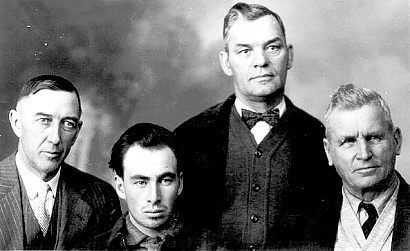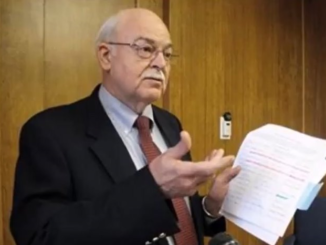
Many years ago, I stumbled across a book while traveling through Williston, North Dakota. Its title captivated me– “End of the Rope: The True Story of North Dakota’s Last Lynching”. Its author is Watford City native and former McKenzie County States Attorney Dennis Edward Johnson. Its a small book – just 54 pages long – that tells a “tale of grisly murder and vigilante justice during the Great Depression” and “what happened when normally law-abiding citizens took the law into their own hands and took their fury out on a confessed murderer.”
It’s a little known story. Yet, a fascinating one nonetheless. For that reason, I want to share with you a summary of the Charles Bannon story, as gleaned from the aforementioned book and the North Dakota Supreme Court News.
For our purposes here, we will begin the story on a farm just North of Schafer, North Dakota in February 1930. At this time in the state’s history, Schafer was the County Seat and is located just East of Watford City. Albert Haven (50), his wife Lulia (39), and their four children– Daniel (18), Leland (14), Charles (2), and Mary (2 months old) all lived on the farm. The family had occupied it for ten years.
While the Haven’s were known as reserved people when it came to communicating with neighbors, Albert was known as a successful farmer. The family regularly went to town, and they communicated often with relatives in Minnesota. But by October of 1930, mail was stacking up at the Post Office, loans were past due, and communication with relatives had long ceased. People began to wonder what happened to the Haven’s. Nobody had seen any of them after February 9, 1930. Haven’s relatives from Minnesota expressed their concerns to authorities.
As a starting point to the investigation, Sheriff Charles Jacobsen determined to visit the Haven farm. Upon arrival, it was discovered that the Haven family was nowhere to be found. But 21-year old Charles Bannon – a hired hand of the Haven’s – was found to be living there. And his story about the whereabouts of the Haven family was unconvincing to Sheriff Jacobsen.
Bannon told the Sheriff that he was taking care of the farm for the Haven’s and that they had moved back to Colton, Oregon. Suspicious of the story, Sheriff Jacobsen checked with the Postmaster in Colton and received this response:
“No one named Haven here, or been here in the last few years. No mail received here for Haven. This place is a hamlet, few families. No trace of a Haven in the district.”
With confirmation in hand that the Haven’s weren’t in Colton, Oregon; Sheriff Jacobsen had one more lead to check on. Bannon had also told the Sheriff that he had personally driven the family to Williston to take the train to Oregon. A simple check with the ticket agent in Williston resulted in there being no recollection of the Haven’s.
On a return trip to the farm, Bannon showed Sheriff Jacobsen and State’s Attorney J.S. Taylor a letter he claimed to have received from Daniel– the Haven’s oldest son. The letter was full of misspellings. Later, when county authorities contacted Daniel’s school teacher, they were told that he was a good speller.
In their return visit to the farm, authorities also learned that Charles Bannon’s father – James F. Bannon – had been on the farm since February of 1930, but according to Charles had gone back to Oregon to “find the Haven outfit”.
Though the situation was highly suspicious, Sheriff Jacobsen had no concrete evidence against Bannon. But then he caught a break. As a result of Charles selling some hogs from the farm – in addition to taking all the grain, straw, and hay – the State’s Attorney initiated a complaint against Charles Bannon for Larceny. On December 12, 1930, Sheriff Jacobsen – accompanied by C.E. Evanson, who had previously been appointed “Public Administrator” over the Haven property – drove to the farm and arrested Charles Bannon.
As a result of the arrest, more evidence into the disappearance of the Haven’s surfaced. In the house, Sheriff Jacobsen found winter clothing for the family. Remember, it was February when the family disappeared. And it was alleged by Charles Bannon that they had gone to Oregon. I don’t have to explain to you what winters in North Dakota are like in February. Bannon’s story wasn’t adding up.
With suspicion greater than ever, the Sheriff set out for Williston to put Charles in jail. The idea behind putting him in Williston, rather than Schafer, was that he would be much safer. By this time in the investigation, rumors were spreading– as is often the case in small communities. People were talking about the possibility of Charles Bannon being responsible for the disappearance of the Haven’s.
While processing Charles for the trip to Williston, a deputy discovered a crumpled letter in Charles’ pocket. It was dated December 2, 1930 and was from James Bannon– Charles’ father. While the letter mentions looking for the Haven’s, there was a separate sheet – in the same handwriting – that was highly suspicious. James warned Charles:
“Now Charles watch your Sep and see that every thing is right and do what is right and then thair will be no com Back you no your Bisnes Better then any one else write and let me now how every thing is…”
While in Williston jail, a man from the newspaper sought permission to interview and trick Charles into giving a writing sample. Charles Bannon consented and wrote as requested. In doing so, he unknowingly provided a paragraph that contained the exact same misspelled words as those in the alleged letter from Daniel Haven. It was evident– Charles Bannon had written the letter he said was Daniel’s.
Considering everything that authorities knew, it still wasn’t enough. Everything pointed to Charles Bannon being involved in the disappearance of the Haven’s, but there was no hard evidence– it was all circumstantial. Even confronting Charles with the facts of the investigation initially proved fruitless.
But the day after being confronted with the facts of the case, Charles was visited by his mother, Ella Bannon. In addition to her visit, he also saw a minister and his attorney A.J. Knox. It was this visit that started to break Charles Bannon. He claimed that Lulia Haven had gone insane and killed the entire family– except for little Charlie. He also indicated that she had paid him $100 to take her to Williston to catch the train after he helped her bury the bodies.
While Charles’ story later proved untrue, he did give a vital piece of information that helped authorities to eventually uncover the truth. That piece of information was found in the form of a map Charles drew of the barnyard showing where he had “helped” bury the bodies.
This time Sheriff Jacobsen would not only be accompanied to the farm by the State’s Attorney and Public Administrator, but Charles’ attorney, the minister, and Ella Bannon went along too. Using the map provided by Charles, Sheriff Jacobsen and C.E. Evanson turned the first shovels from the manure pile. It was here that they discovered the partial remains of little Charles Haven.
Moving to a straw pile, they uncovered the remains of Albert, Daniel, and Leland. But that wasn’t all. Charles Bannon’s own attorney, A.J. Knox, noticed something else. Digging further with a tined pitchfork, Sheriff Jacobsen uncovered the partial remains of little Mary Haven and Lulia– the mother. The discovery of Mrs. Haven proved again that Charles Bannon hadn’t told the truth.
With the bodies, or parts of bodies, of each member of the Haven family accounted for – and with evidence of Charles Bannon having lied again – Sheriff Jacobsen, Deputy Sheriff Earl Gordon, State’s Attorney Taylor, and attorney A.J.Knox confronted Charles. All of them pleaded with him to tell the truth. Eventually, Charles Bannon confessed. As a result, Sheriff Jacobsen and County Coroner Harry Larsen later located the missing remains of Lulia Haven and little Charles.
In January of 1931, Charles Bannon wrote what would become his third and final confession. In his confessions, Charles details the fateful events of that tragic day in February in which he ended the lives of the entire Haven family. The details are awful. I’ll spare you my repeating them here. But I will share with you the event that triggered it. In his own words, Charles Bannon said:
“We had milked some of the cows before this time. But these were the cows that we were milking when Leland came to barn. Leland had a gallon pail in his hand, he stepped over to Daniel and said, give me some milk for breakfast. Daniel said go and milk some for yourself.
“I got thru with my share of the cows, or I thot so at least. Daniel said you better milk that other cow you Son of a Bitch. I was laughing and Danny laughed when he said this to me. I stepped back and took a 25-20 rifle off the side of saddle horn.
“I said ‘What did you say’ and he called me the same name again. I pointed the gun at him, and did not pull the trigger. Danny was sitting and looking at me at time, the gun went off and shot him in the right temple killing him dead.”
Knowing what had happened, Leland rose up and tried to shoot Charles Bannon. Charles returned fire and killed Leland. Discovering what had happened, Albert and Lulia pursued Charles. Albert said, “He won’t get away from here alive.” Charles then killed Lulia and Albert before proceeding to the house to kill little Charles Haven and baby Mary.
As a result of the confessions, the necessary legal maneuvers were made to track down James Bannon in Oregon. He was extradited back to North Dakota to face charges of being complicit in the murders of the Haven family. This was all done in spite of the fact that Charles Bannon insisted that his father had absolutely nothing to do with the atrocity.
With confessions in hand, Charles Bannon was released from Williams County Jail in Williston and taken back to McKenzie County to face murder charges. You’ll recall that Charles was originally taken to Williston for reasons of safety. It wasn’t long and those concerns proved to be well founded.
By this time, word had spread that Charles Bannon had confessed to the murders. Many citizens of McKenzie County were convinced that Charles would somehow not be convicted. An interesting side note to this is that not only were they convinced justice may not prevail, but North Dakota didn’t have the death penalty either.
On January 29, 1931 – just after midnight – about 75 masked men from all over McKenzie County descended on the stone jailhouse at Schafer where Charles Bannon, James Bannon, and a confessed thief named Fred Makie were being held. Using a heavy timber, the mob battered down the door and demanded that the deputy on duty, Peter Hallan, give them access to Charles Bannon. Deputy Hallan refused to cooperate.
Living close by to the jail was the new Sheriff, Syvert Thompson. Sheriff Thompson awoke and came to investigate what the commotion was all about, but was taken captive and led away. As a result of someone cutting the telephone line, there was no way to call for backup.
With an enormous amount of persistence, and a unified effort, the mob finally broke down the steel door standing between them and Charles Bannon. They then locked up Sheriff Thompson, Deputy Hallan, James Bannon, Fred Makie, and took Charles with them.
At first, the mob took Charles to the Haven farm, but were ran off by an armed C.E. Evanson. From there they continued on to the bridge at Cherry Creek, which is not far from Schafer. Tying Charles Bannon’s hands behind his back, and putting one end of a noose around his neck and the other around the bridge, Charles was reportedly lifted to the railing where he was encouraged to jump. Charles allegedly responded:
“You boys started this. You will have to finish this.”
Reports vary in the details, but finish it they did. Charles Bannon was pushed off the bridge, resulting in what the coroner described as a “fractured neck”.
On duty that night in Watford City was Chief of Police Hans Nelson. The Chief had been warned of the possible lynching, but initially thought it was a joke. When a friend told him a mob may be in Schafer to get Charles Bannon, he drove there to find out– only to discover the jail had been broken into. Chief Nelson arrived at the bridge at 2:30am and later shared what he found:
“It was a cold, misty night. The body was hanging from the bridge, just barely turning in the cold, grisly night.”
The Chief walked down the embankment by the creek and pushed the dead body of Charles Bannon up while others pulled him to the top.
Word spread quickly about the lynching of Charles Bannon. The actions of the mob were considered homicide and the Attorney General of North Dakota, James Morris, called for a special investigator to identify the guilty parties and to charge them with murder. Governor George Shafer publicly denounced the mob’s actions and ordered an investigation.
In spite of Charles Bannon’s claims to the contrary, James Bannon was later tried and convicted for the murders of the Haven family. His sentence was life in prison. His lawyers appealed the case all the way to the North Dakota Supreme Court and claimed there was no evidence to support the claims against him. Yet, the appeal was to no avail. The court upheld his conviction. But after serving 19 years, and at the age of 76 years old, James Bannon was diagnosed with a terminal illness and was released from prison. Not long after, he died.
Despite the public statements of the Attorney General and Governor condemning the lynching and demanding justice, nothing ever came of it. To this day, not one person involved in the lynching of Charles Bannon was ever identified.
As I sat with members of my own family some nights ago, and shared with them the story of North Dakota’s last lynching, their response was typical of many, “It sounds like he got what he deserved.” This was the opinion of those in the mob, their families, and others who either remained silent or spoke in “hushed tones” in the years that followed the death of Charles Bannon. Spoken or unspoken, there seems to have been an oath among these people that nobody ever be outed.
Many years ago, my own father was visiting with a man who was native to the Watford City area. This man – then over 90 years old – went uncharacteristically silent when my father asked him about the lynching of Charles Bannon. With no response to the question, the subject was changed. I’ve always been intrigued by that.
Without question, each one of the men in the mob that fateful January day are now gone– and with them the details that ended in vigilante justice on a bridge in McKenzie County, North Dakota. Nevertheless, what we do know of the story will live in the annals of North Dakota history forever.
***Note: If you have any stories or information regarding the lynching of Charles Bannon, please feel free to comment on Facebook.
Sources:
- Johnson, Dennis Edward. End of the Rope: The True Story of North Dakota’s Last Lynching. North Dakota: Crain Grosinger Publishing, 2005. Print.
- http://www.ndcourts.gov/Court/News/Bannon/bannon.htm





